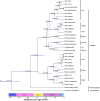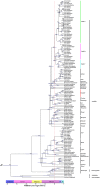Rapid and recent diversification patterns in Anseriformes birds: Inferred from molecular phylogeny and diversification analyses
- PMID: 28892502
- PMCID: PMC5593203
- DOI: 10.1371/journal.pone.0184529
Rapid and recent diversification patterns in Anseriformes birds: Inferred from molecular phylogeny and diversification analyses
Abstract
The Anseriformes is a well-known and widely distributed bird order, with more than 150 species in the world. This paper aims to revise the classification, determine the phylogenetic relationships and diversification patterns in Anseriformes by exploring the Cyt b, ND2, COI genes and the complete mitochondrial genomes (mito-genomes). Molecular phylogeny and genetic distance analyses suggest that the Dendrocygna species should be considered as an independent family, Dendrocygnidae, rather than a member of Anatidae. Molecular timescale analyses suggests that the ancestral diversification occurred during the Early Eocene Climatic Optimum (58 ~ 50 Ma). Furthermore, diversification analyses showed that, after a long period of constant diversification, the median initial speciation rate was accelerated three times, and finally increased to approximately 0.3 sp/My. In the present study, both molecular phylogeny and diversification analyses results support that Anseriformes birds underwent rapid and recent diversification in their evolutionary history, especially in modern ducks, which show extreme diversification during the Plio-Pleistocene (~ 5.3 Ma). Therefore, our study support that the Plio-Pleistocene climate fluctuations are likely to have played a significant role in promoting the recent diversification for Anseriformes.
Conflict of interest statement
Figures




References
-
- Turner GF. The ecology of adaptive radiation. Heredity. 2001;86(6):749–50.
-
- Simpson GG. The major features of evolution. New York: Columbia University Press; 1953.
-
- Osborn HF. The law of adaptive radiation. Am Nat. 1902;36(425):353–63.
-
- Yu W, Wu Y, Yang G. Early diversification trend and Asian origin for extent bat lineages. J Evolution Biol. 2014;27(10):2204–18. - PubMed
-
- Lovette IJ, Bermingham E. Explosive speciation in the New World Dendroica warblers. Proc R Soc Lond B. 1999;266(1429):1629–36.
MeSH terms
LinkOut - more resources
Full Text Sources
Other Literature Sources

